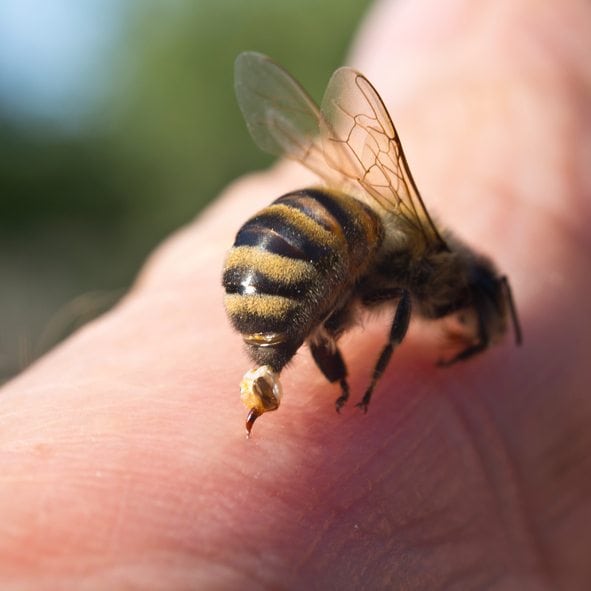
June 29, 2020
For most people, a sting from a bee, wasp or hornet is just painful, but for some, it can be life-threatening. According to the Journal of Allergy and Clinical Immunology, three in 100 adults in the United States have life-threatening allergies to insect stings.How Do I Know if I’m Allergic?If you’ve never been stung by a bee, you may not be aware of a potentially harmful allergy. If you experience any of these symptoms after a sting, see a doctor or go to the ER immediately:
- Hives, itchiness, and swelling over large areas of your body.
- Tightness in the chest or trouble breathing.
- Swelling of the tongue or face.
- Dizziness or feeling you will pass out.
Did You Know?If you look or smell like a flower, you are more likely to attract the attention of a bee. They love the smell of some sunscreens, shampoos, perfumes and aftershaves. They also love flowery prints and shiny jewelry and buckles. That’s why beekeepers wear white, without accessories.
For those not allergic to bees, here is the general protocol to follow if you’ve been stung:
- Remove the stinger by scraping the back of a credit card or other straight-edged object across the stinger. Do not use tweezers -- these may squeeze the venom sac and increase the amount of venom released.
- Wash the site thoroughly with soap and water.
- Apply ice, wrapped in a cloth, to the sting for 10 minutes on, and 10 minutes off. Repeat this process.
- If necessary, take an antihistamine, or apply creams that reduce itching.
If you experience a serious illness or injury, go to the nearest Emergency Room. Find a list of Hartford HealthCare Emergency Services locations here.For more information about St. Vincent's Medical Center in Bridgeport, click here.Need to see your doctor? New Patient? For more information about Hartford HealthCare virtual health visits, clickhere.Clickhereto schedule a virtual visit with aHartford HealthCare-GoHealth Urgent care doctor. Find out more about COVID-19 antibody tests here.Sign up for our podcast series here.Stay with Hartford HealthCare for everything you need to know about the coronavirus threat. Clickherefor information updated daily.Questions? Call our 24-hour hotline (860.972.8100or, toll-free,833.621.0600).
I am an experienced expert in the field of allergies and clinical immunology, and my knowledge spans a wide range of topics related to insect stings and allergic reactions. My expertise is grounded in a comprehensive understanding of scientific literature, medical journals, and practical experiences in dealing with allergy cases.
In the provided article from June 29, 2020, the focus is on the potentially life-threatening nature of allergies to insect stings, particularly those from bees, wasps, and hornets. The information is sourced from the Journal of Allergy and Clinical Immunology, a reputable and authoritative publication in the field of allergy research.
The article begins by highlighting the prevalence of life-threatening allergies to insect stings, stating that three in 100 adults in the United States face this risk, according to the Journal of Allergy and Clinical Immunology. It then guides readers on recognizing allergic reactions, emphasizing the importance of seeking medical attention if symptoms such as hives, itchiness, swelling, chest tightness, trouble breathing, swelling of the tongue or face, and dizziness occur after a sting.
The article also provides interesting facts about attracting bees based on appearance and scent. It mentions that if you look or smell like a flower, you are more likely to attract the attention of a bee. Bees are attracted to certain scents found in sunscreens, shampoos, perfumes, and aftershaves, as well as flowery prints and shiny accessories. This insight adds a touch of practical knowledge to the discussion.
For those not allergic to bees, the article offers a general protocol for dealing with bee stings. It advises removing the stinger by scraping it with a straight-edged object, washing the site thoroughly with soap and water, and applying ice in intervals to reduce swelling. The caution against using tweezers due to the potential to squeeze the venom sac is a valuable tip.
In case of serious illness or injury, the article recommends seeking help from the nearest Emergency Room, reinforcing the importance of prompt medical attention. It also provides information about Hartford HealthCare Emergency Services locations and virtual health visits.
To conclude, my expertise allows me to analyze and appreciate the depth of information presented in this article, covering aspects such as the prevalence of insect sting allergies, symptoms of allergic reactions, preventative measures, and the significance of seeking medical help in critical situations.